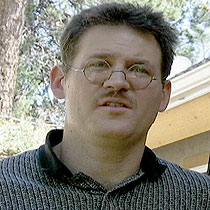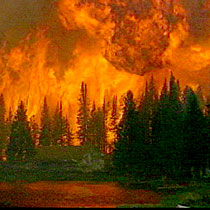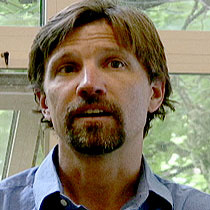-
(单词翻译:双击或拖选)
Colorado
21 August 2007
The natural beauty of the American West is prompting more people to build homes in wildland areas. Wildfires are also natural in those areas, and as climate change increases temperatures and drought, blazes are increasing, too. And that increases the importance of educating homeowners about the hazards of wildfires. From Colorado, Shelley Schlender reports.
 |
| Eric Phillips |
When Eric Philips drives along a mountain lane, he is not looking at the scenery. As the coordinator1 of Boulder2 County's wildfire mitigation effort, Philips keeps an eye on thousands of mountain homes. "On a wildland fire, it moves so fast and there are so many houses potentially at risk, there's some houses that are not going to make it through the fire."
While many mountain dwellers3 believe that a wildfire will never hit them, Philips urges all of them to be prepared. "We're not in a position where we can really discourage people from building in the mountains. They have a legal right to the building lots that they have. What we do is to encourage and require them to have buildings that are built well."
 |
| Colorado wildfires |
Another problem shows up when a crane being trucked in for the home's remodeling squeezes down the country lane. "Do you see how this crane is having difficulty getting in here? This is about the same size as a fire truck and you can imagine a fire truck trying to back in here. Very difficult."
Building officials are requiring the remodeling team to use extremely fire resistant4 materials, such as cement board siding, plus metal clad doors and windows.
 |
| David Theobald |
Almost 90 percent of forest fire fighting efforts in the United States go toward protecting homes, Theobald says, and it is mostly done with public money.
Which means less public funding for mountain watersheds7 or habitat protection. Theobald wants more public dialogue about permitting people to build in fire-prone areas, and about how to pay for protecting them. He says these are issues whenever people live in beautiful, but hazardous8, locations.
"Katrina happens, and we say, 'Oh my gosh it's a terrible thing, it is, it's a terrible thing.' But we react to it and we go, and we rebuild that area. Should we do it? I don't know."
Carrie Radde owns a mountain home. She says that she and her family work hard to reduce the fire hazard. "We've cut down a lot of the trees right around our house. We've tried to put gravel9 around the edges of the house to have that be defensible. We mow10 down the weeds, you know, the small bushes that could easily catch on fire."
Wildfire official Eric Philips says that if more mountain dwellers took steps like these their homes would have a better chance. "If you parked a fire engine here and were able to fight the fire here, this is one of those houses where you might decide to make the stand."
To reduce the expense and danger of taking that stand, fire experts like Dave Theobald hope that lawmakers will pay attention to the growing number of houses being built in fire-prone areas, so that they create clearer policies for managing the costs.
 收听单词发音
收听单词发音
1
coordinator

|
|
| n.协调人 | |
参考例句: |
|
|
|
2
boulder

|
|
| n.巨砾;卵石,圆石 | |
参考例句: |
|
|
|
3
dwellers

|
|
| n.居民,居住者( dweller的名词复数 ) | |
参考例句: |
|
|
|
4
resistant

|
|
| adj.(to)抵抗的,有抵抗力的 | |
参考例句: |
|
|
|
5
geographer

|
|
| n.地理学者 | |
参考例句: |
|
|
|
6
blistering

|
|
| adj.酷热的;猛烈的;使起疱的;可恶的v.起水疱;起气泡;使受暴晒n.[涂料] 起泡 | |
参考例句: |
|
|
|
7
watersheds

|
|
| n.分水岭( watershed的名词复数 );分水线;转折点;流域 | |
参考例句: |
|
|
|
8
hazardous

|
|
| adj.(有)危险的,冒险的;碰运气的 | |
参考例句: |
|
|
|
9
gravel

|
|
| n.砂跞;砂砾层;结石 | |
参考例句: |
|
|
|
10
mow

|
|
| v.割(草、麦等),扫射,皱眉;n.草堆,谷物堆 | |
参考例句: |
|
|
|















